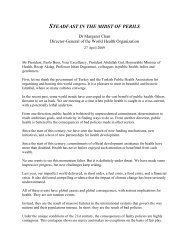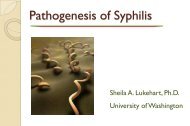The Evolution of HTA in Emerging Markets Health-Care ... - TREE
The Evolution of HTA in Emerging Markets Health-Care ... - TREE
The Evolution of HTA in Emerging Markets Health-Care ... - TREE
You also want an ePaper? Increase the reach of your titles
YUMPU automatically turns print PDFs into web optimized ePapers that Google loves.
OHE Consult<strong>in</strong>g Report for PhRMA<br />
5 January 2011<br />
the ability <strong>of</strong> their Department to generate additional <strong>in</strong>come from the sale <strong>of</strong> extra services. Given<br />
the ability to earn much-‐needed revenue <strong>of</strong>f <strong>of</strong> the marg<strong>in</strong>s allowed <strong>in</strong> pharmaceutical sales,<br />
hospitals therefore tend to provide <strong>in</strong>centives to doctors to over-‐prescribe. Not unsurpris<strong>in</strong>gly<br />
there is drug over-‐prescription, and <strong>in</strong>consistent prescription has become a serious problem.<br />
<strong>The</strong> government has recognized this problem and are work<strong>in</strong>g to phase out mark-‐ups allowed on<br />
pharmaceutical sales, <strong>in</strong>clud<strong>in</strong>g on the co-‐pays that patients pay. This is be<strong>in</strong>g presented as a benefit<br />
<strong>of</strong> health care reform – lower drug prices for patients. But it creates challenges for hospital f<strong>in</strong>ances.<br />
<strong>The</strong> MoH is propos<strong>in</strong>g to <strong>in</strong>troduce a dispens<strong>in</strong>g fee (an Rx service fee) to tackle the problem, i.e.<br />
replac<strong>in</strong>g a 15% hospital percentage mark up with a flat rate (10 RMB or $1.50) per-‐item charge<br />
which would remove the <strong>in</strong>centive to prescribe higher priced drugs but not the <strong>in</strong>centive to<br />
overprescribe. This reform is be<strong>in</strong>g presented as a price cut for patients (<strong>in</strong> the form <strong>of</strong> lower co-payments)<br />
and so as a benefit <strong>of</strong> health reform. Logically the fee schedule for other th<strong>in</strong>gs could go<br />
up, but this would be seen as a price <strong>in</strong>crease for patients via the co-‐payment so is difficult for the<br />
MoH to implement.<br />
To expect that the NDRC can oversee thousands <strong>of</strong> medical products and services and to efficiently<br />
control their prices under a fee-‐for-‐service schedule that covers all <strong>of</strong> Ch<strong>in</strong>a seems to be unrealistic.<br />
Arguably, prices need to be decentralized <strong>in</strong> order to solve this problem. However, this presupposes<br />
the <strong>in</strong>troduction <strong>of</strong> effective purchas<strong>in</strong>g and <strong>in</strong>centives for quality and efficiency, which can drive<br />
reform to the delivery system that is suitable for a population with <strong>in</strong>creas<strong>in</strong>g chronic conditions and<br />
reduce <strong>in</strong>efficiencies. It needs to <strong>in</strong>tegrate prevention, primary and hospital care, and re-‐orient care<br />
away from hospitals to primary and community based care.<br />
<strong>The</strong> need for the active purchas<strong>in</strong>g <strong>of</strong> population health care.<br />
<strong>The</strong>re is little understand<strong>in</strong>g with<strong>in</strong> the health care system nationally and locally <strong>of</strong> purchas<strong>in</strong>g and<br />
contract<strong>in</strong>g for health care services and it is unclear how improvements <strong>in</strong> delivery <strong>in</strong>tegration and<br />
efficiency can be brought about. <strong>The</strong>re are experiments <strong>in</strong> some prov<strong>in</strong>ces with:<br />
<br />
<br />
<br />
<br />
provider payment methods l<strong>in</strong>ked to the use <strong>of</strong> cl<strong>in</strong>ical protocols for some <strong>of</strong> the most<br />
prevalent health conditions,<br />
the design <strong>of</strong> a benefit package to reduce f<strong>in</strong>ancial barriers to access care and to motivate<br />
patients to use primary-‐based care;<br />
use <strong>of</strong> technology (e.g. mobile phone) to improve patient compliance;<br />
the conduct <strong>of</strong> patient education programmes on prevention, healthy lifestyle and best-practice<br />
care.<br />
A note on one experiment <strong>in</strong> N<strong>in</strong>gxia prov<strong>in</strong>ce is <strong>in</strong>cluded <strong>in</strong> an Annex to this Appendix.<br />
<strong>The</strong>re are efforts to develop cl<strong>in</strong>ical practice guidel<strong>in</strong>es, and the MoH is seek<strong>in</strong>g around 400 cl<strong>in</strong>ical<br />
guidel<strong>in</strong>es <strong>of</strong> which around 100 have been published. <strong>The</strong>se have mostly been developed over a<br />
short period by the Teach<strong>in</strong>g Hospital at Beij<strong>in</strong>g University and draw on relevant guidel<strong>in</strong>es from<br />
other health care systems. Hospitals <strong>in</strong> the Prov<strong>in</strong>ces have also been asked to develop guidel<strong>in</strong>es.<br />
However, it is not clear whether there is an agreed protocol for the development <strong>of</strong> national or local<br />
88








